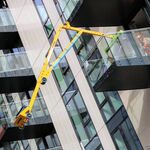If the 401/Yonge Street interchange is redesigned competently it could go a long way in making that area less of a death trap to people walking or biking. And between the bike lanes set to be installed on Yonge next year, the Yonge redesign in North York that will hopefully get approved tomorrow, and this project we could someday have a pretty decent north-south cycling route along the Yonge corridor.
I know, that's a lot of ifs.
I think it would make even more sense economically to expand intercity rail and other highways to spread out traffic. The 401 is mainly the lifeblood because we have so few other routes. Quebec, for example, has two highways from Montreal to Quebec City. Instead of widening the 401 east of Cobourg to 6 lanes, we could expand Highway 7 between Peterborough and Carleton Place, which is a more direct route and would divert a large amount of traffic off the 401. It would also bring economic benefits to that part of eastern Ontario. Via's HFR plan has the potential to expand the modal share of trains significantly, reducing pressure on the 401 further. Similarly, substantial rail expansion to southwestern Ontario and Niagara would do the same there.
It is at some interchanges, like Highway 7 at the 404. Pedestrians are still forced to cross an on-ramp though, dodging accelerating cars. The standard MTO design for interchanges is awful for anyone who's not in a car.





